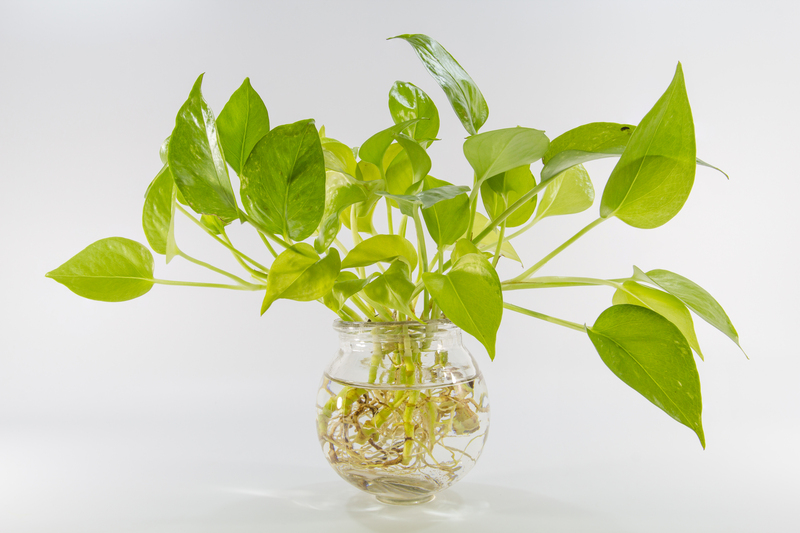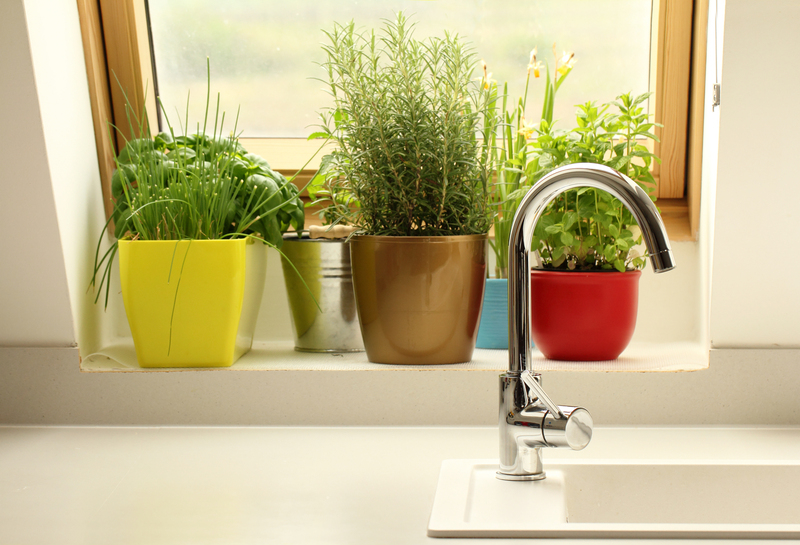Crafting a Garden Sanctuary with Dogs
Posted on 17/06/2025
Crafting a Dog-Friendly Garden Sanctuary: The Ultimate Guide
Every dog owner dreams of a beautiful garden where plants flourish, and four-legged friends can safely romp and relax. Designing a garden sanctuary with dogs in mind isn't just about aesthetics--it's about creating a safe, stimulating, and sustainable environment for your canine companions. In this comprehensive guide, we'll explore all facets of crafting a garden sanctuary with dogs, from choosing the right plants to integrating play areas and maintaining both your garden's health and your dog's happiness.

Why Design a Dog-Friendly Garden Sanctuary?
Gardens aren't just for humans; they're a source of endless joy and stimulation for our pets as well. Dogs thrive outdoors, exploring scents, sights, and sounds. But an ordinary garden can present hazards--poisonous plants, sharp objects, and fragile landscaping can lead to problems. By intentionally crafting a garden sanctuary that's tailored to your dog's needs, you create a harmonious space where plant life and pet life flourish together.
The Benefits of a Canine-Focused Outdoor Space
- Safety: Minimize exposure to toxic flora, chemicals, and hazards.
- Well-being: Encourage physical activity and mental stimulation.
- Harmony: Reduce complaints about digging, chewing, or escape attempts.
- Aesthetics: Design a beautiful space that balances your interests with your dog's needs.
Planning: The Foundation of a Dog-Friendly Garden Sanctuary
Understand Your Dog's Behavior and Needs
Before designing your perfect dog garden sanctuary, observe your pet. Where do they like to dig? Do they bask in the sun or seek shade? Are they escape artists or calm loungers? Each dog is unique, and understanding their quirks is essential to successful landscaping.
- Pathways: Dogs often create their own paths. Rather than battling natural trails, incorporate them into your design!
- Resting Spots: Provide both sunny and shady places for lounging to accommodate different weather preferences.
- Play Zones: Dedicate areas for fetch, agility, or digging to keep your dog entertained and engaged.
- Water Access: Dogs need fresh water. Consider a decorative water feature or an easy-to-clean, shaded water bowl area.
Assess Your Garden Space
Every yard has unique dimensions, microclimates, and soil conditions. Conduct a quick survey:
- Size and Shape: Is there room for a separate dog zone, or must dogs share the entire space?
- Sun vs. Shade: Track sun exposure to guide both plant and dog comfort decisions.
- Fencing and Boundaries: Note weak spots where a motivated dog might dig or climb out, and plan reinforcements.
- Soil Quality: Rich soils mean happy plants and less paw mess. Consider easy-to-clean ground covers for muddy, high-traffic areas.
Choosing Safe and Durable Plants for Your Dog Sanctuary
Avoiding Hazardous Flora
Many common garden plants are toxic to dogs. Always cross-reference your plant list with resources like the ASPCA's poisonous plants database. Dangerous plants include:
- Azaleas and Rhododendrons
- Oleander
- Sago Palm
- Foxglove
- Autumn Crocus
- Lilies (highly toxic to cats; some risk to dogs)
Tip: When in doubt, opt for non-toxic, pet-safe plants and always supervise your dogs, especially young pups prone to nibbling.
Best Plants for a Dog-Friendly Garden
- Lavender: Hardy and deters fleas.
- Rosemary: Non-toxic and aromatic.
- Sunflowers: Impressive, safe, and attract pollinators.
- Camellias: Lush, non-toxic shrubs.
- Marigolds: Repel pests naturally and brighten borders.
- Bamboo: Quick-growing and creates natural dog-proof screens.
Mix shrubs, perennials, and hardy ground covers to create layers and textures that fascinate both people and pets.
Protecting Your Plants and Lawn from Dog Damage
Preventing Digging and Trampling
Even the most disciplined pup may be tempted to dig or zoom around flowerbeds. Here are strategies to minimize damage while retaining beauty:
- Dog Paths: Install stone or mulch trails along commonly trodden routes.
- Raised Beds and Barriers: Use decorative fencing or raised planters to shield delicate flowers.
- Dedicated Dig Zone: Fill a sandpit or loose soil area with buried toys to channel digging instincts.
- Paw-Friendly Ground Covers: Use clover, creeping thyme, or artificial turf for persistent wear zones.
A healthy lawn requires regular watering, strong root systems, and sturdy grass varieties like Bermuda or Kentucky bluegrass, which withstand frequent foot traffic.
Essential Features for Your Dog Garden Sanctuary
Secure Fencing and Boundaries
The backbone of any garden designed for dogs is the fence. Whether you prefer wood, vinyl, metal, or invisible barriers (for supervised dogs), prioritize:
- Height: Most dogs can clear a four-foot fence--a six-foot barrier is ideal for athletic breeds.
- No Gaps: Small dogs or puppies can squeeze through surprisingly tight spots.
- Buried Base: Install the fence several inches below ground to prevent digging escapes.
- Self-Closing Latches: Gates should be secure and difficult for clever dogs to open.
Comfort and Enrichment Features
- Shade: Plant fast-growing trees or install shade sails and pergolas for relief on hot days.
- Water: A shallow pond, fountain, or splash pad is both beautiful and functional.
- Shelter: Provide doghouses or covered spots to escape unexpected weather.
- Play Structures: Agility tunnels, logs, ramps, and sturdy toys keep your dog invigorated.
Group seating for humans near play zones means everyone can enjoy the outdoor space together--a true garden sanctuary for all.
Pathways, Edging, and Mulch Choices
Dog-friendly paths encourage safe exploration and protect flowerbeds. Choose durable, non-slip materials:
- Pavers or flagstones are easy on paws and reduce mud.
- Natural mulch like cedar or pine is safer than cocoa mulch, which is poisonous to dogs.
- Edging made from brick, stone, or recycled rubber keeps mulch in place and deters digging.
Maintaining Your Dog Sanctuary Garden
Routine Care and Cleanliness
Dogs can make a garden messier, but routine care keeps your sanctuary healthy and inviting:
- Pick up waste daily to avoid brown spots and pathogens.
- Hose down high-traffic areas to prevent odors, especially on hardscaping.
- Repair damaged sod and reseed as needed--fast-germinating grass mixes are best.
- Trim plants regularly so dogs don't break branches while running or playing.
Eco-Friendly Lawn and Pest Management
Avoid synthetic fertilizers and pesticides that may harm pets and local wildlife. Instead, rely on:
- Organic compost and mulch
- Beneficial insects or nematodes for pest control
- Diatomaceous earth as a safe flea and slug barrier
- Manual weeding and integrated pest management (IPM)
And always rinse your dog's paws after any garden treatments, even if they're pet safe!
Seasonal Tips for Your Dog-Friendly Garden Sanctuary
- Spring: Check fences for gaps, clean water features, and plant new non-toxic flowers.
- Summer: Provide extra shade and shallow water. Watch for signs of heatstroke.
- Fall: Rake leaves, repair lawn wear from summer play, and mulching for winter.
- Winter: Offer shelter, clear snow from dog paths, and avoid salt-based deicers.

Enriching the Garden Sanctuary Experience for Your Dog
Sensory Stimulation
Dogs love to sniff, dig, and chase. Integrate sensory experiences such as:
- Herb spirals: Dogs enjoy smelling (and occasionally tasting) herbs like mint, basil, and parsley.
- Wind chimes or fountains: Add soft sounds that intrigue without frightening.
- Butterfly and bee gardens: Pollinator-friendly plants provide visual interest and environmental enrichment.
Training and Behavior in the Garden
Encourage good garden etiquette using positive reinforcement:
- Reward your dog for using designated paths and play zones.
- Discourage digging in forbidden areas by redirecting to the dig pit.
- Practicing recall ensures dogs come when called, even if enthralled by a butterfly or squirrel.
Consistent training protects both your garden's beauty and your dog's safety.
Conclusion: Your Garden Sanctuary, a Haven for Both People and Pets
With careful planning, plant selection, and regular maintenance, crafting a garden sanctuary for dogs can become a fulfilling project that enhances your home, your lifestyle, and--most importantly--your pet's happiness. The result: a space alive with nature, tailored to every member of your family, where dogs and gardens thrive side by side.
Transform your garden into a true dog sanctuary--where every wag, sniff, and sunbeam brings joy and peace to both canine and human hearts.

